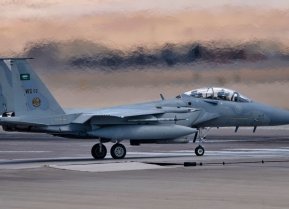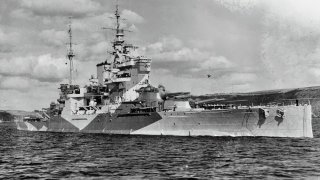Queen Elizabeth-Class: The Royal Navy's Best Battleships Oozing with Firepower
All of the Queen Elizabeth-class battleships had the distinction of fighting in both World Wars, and only Barham remained in her original configuration at the start of the Second World War.
Queen Elizabeth-Class: the Royal Navy's Top Battleship? The HMS Queen Elizabeth (R08) is the largest warship ever built for the Royal Navy, and one of the most advanced military vessels in service in the world today. However, she was named in honor of the World War I super dreadnought that is now widely regarded to be an important milestone in the history of the capital ship.
Developed in the years leading up to the Great War as a fast battleship to replace battlecruisers as the offensive element of the Royal Navy's battle fleet, the Queen Elizabeth-class dreadnoughts were the first to use oil as her sole fuel, and the first battleship to be armed with 308mm (15-inche) guns. Their firepower was designed to overwhelm any existing enemy battleship. The class also had the benefit of very accurate fire control system, which left a profound impression the German High Seas Fleet at the Battle of Jutland in 1916.
Although they have been described as handsome vessels, the handling of HMS Queen Elizabeth and her sister warships was not as good as it might have been. One issue was that they were seriously overweight at the designers attempted to incorporate too many innovations.
Four other warships of the class were built, including HMS Barham, HMS Malaya, HMS Valiant and HMS Warspite; while a sixth planned vessel, HMS Argonaut, was never built.
Notable Facts About HMS Queen Elizabeth-Class
She was laid down in 1912, and launched in October 1913, and completed in January 1915. She was among the warships that took part in the ill-fated Dardanelles Campaign in 1915, before becoming the Fleet Flagship of the Grand Fleet from 1916 to 1918.
In addition to the eight 380mm guns, the ships were originally equipped with sixteen 152mm guns, which were later removed and replaced with twenty dual purpose 114mm (4.4) quick-firing guns.
The warship displaced 33,548 tonnes (33,020 tons) and had overall length of 640 feet, 10.5-inch (95.4 meters); and a beam of 90 feet, six inches (27.58 meters). A distinguishing feature of the class was its heavy tripod foremast and pole-type mainmast. HMS Queen Elizabeth underwent numerous changes during her service, and her conning tower was redesigned and enlarged during construction.
In the 1930s Queen Elizabeth and Valiant were reconstructed and their two funnels replaced by a single large one, the forward funnel being trunked into the second. In addition, a midships' hanger was fitted as part of the reconstruction program, and it was used to house a Supermarine Walrus spotter aircraft.
All of the Queen Elizabeth-class battleships had the distinction of fighting in both World Wars, and only Barham remained in her original configuration at the start of the Second World War. Her planned reconstruction was postponed when the war broke out in September 1939, and she was sunk after being hit by torpedoes fired by the German U-boat U331 off the coast of Sollum on November 25, 1941.
Queen Elizabeth-Class: The End of a Battleship Dynasty for the Royal Navy
HMS Queen Elizabeth and HMS Valiant were each badly damaged by Italian frogmen while in port in Alexandria in December 1941. The two ships were repaired and apart from Barham, all four survived the war despite taking considerable punishment. Sadly the entire class of super dreadnoughts met the same fate as many great warships of the era – they were sold for scrap. Yet, their contribution in the two great conflicts of the 20th century can't be understated.
About the Author
Peter Suciu is a Michigan-based writer who has contributed to more than four dozen magazines, newspapers and websites. He regularly writes about military hardware, and is the author of several books on military headgear including A Gallery of Military Headdress, which is available on Amazon.com. Peter is also a Contributing Writer for Forbes.


